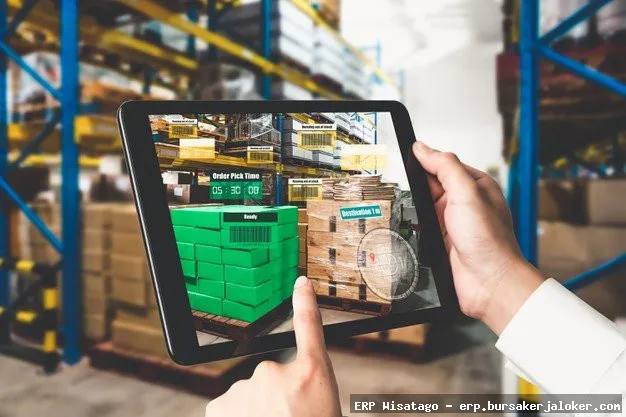The supply chain. It’s the lifeblood of any product-based business, the intricate network connecting raw materials to finished goods in the hands of your customers. For years, I witnessed firsthand how inefficient and disconnected supply chains could cripple even the most promising companies. Spreadsheets overflowing with data, endless email threads, and a constant feeling of being one step behind – it was a recipe for missed deadlines, cost overruns, and frustrated customers. That’s when I started digging into Enterprise Resource Planning (ERP) systems and their potential to revolutionize supply chain management.
ERP isn’t just about accounting or HR anymore. Modern ERP solutions offer powerful tools specifically designed to streamline and optimize every aspect of your supply chain, from forecasting demand to managing inventory and ensuring timely delivery. The promise is a more transparent, efficient, and responsive supply chain, one that can adapt to changing market conditions and give you a significant competitive advantage. But implementing an ERP system is a significant undertaking, and choosing the right one for your business is crucial.

In this guide, I’ll share my experiences and insights into ERP for supply chain management. We’ll explore the key features and benefits, discuss the common challenges of implementation, and provide practical advice on selecting the ERP solution that best aligns with your business needs. Whether you’re just starting to explore ERP or looking to upgrade your existing system, this guide will provide you with the knowledge you need to make informed decisions and unlock the full potential of your supply chain.
What is ERP for Supply Chain Management?
ERP for Supply Chain Management (SCM) is the integration of ERP software modules specifically designed to manage and optimize all aspects of a company’s supply chain. Instead of relying on disparate systems and manual processes, an ERP system provides a centralized platform for planning, executing, and monitoring the flow of goods, information, and finances across the entire supply chain.
Core Components of ERP for SCM
A comprehensive ERP for SCM system typically includes the following key components:
- Demand Forecasting: Analyzing historical data and market trends to predict future demand for products.
- Inventory Management: Optimizing inventory levels to minimize holding costs while ensuring sufficient stock to meet demand.
- Production Planning: Scheduling production activities based on demand forecasts and available resources.
- Materials Management: Managing the procurement of raw materials and components, including vendor selection and purchase order processing.
- Warehouse Management: Optimizing warehouse operations, including receiving, storage, and shipping.
- Transportation Management: Planning and executing the movement of goods from suppliers to customers, including route optimization and carrier selection.
- Order Management: Processing customer orders from placement to fulfillment, including order tracking and shipping notifications.
- Supply Chain Analytics: Providing real-time visibility into supply chain performance through dashboards and reports.
Benefits of Implementing ERP for Supply Chain Management
The advantages of implementing an ERP system for supply chain management are numerous and can significantly impact a company’s bottom line. Here are some of the most significant benefits:
Improved Visibility and Transparency
One of the biggest advantages of ERP is the enhanced visibility it provides across the entire supply chain. With all data centralized in a single system, you can track the status of orders, inventory levels, and shipments in real-time. This improved visibility allows you to identify potential bottlenecks and proactively address issues before they impact your operations. I remember one instance where we identified a supplier consistently delivering late through the ERP‘s reporting features. We were able to switch to a more reliable supplier, avoiding significant production delays.
Increased Efficiency and Productivity
ERP automates many of the manual processes involved in supply chain management, such as purchase order processing, inventory tracking, and shipping documentation. This automation frees up employees to focus on more strategic tasks, leading to increased efficiency and productivity. We saw a dramatic reduction in manual data entry errors and a significant improvement in order fulfillment times after implementing our ERP system.
Reduced Costs
By optimizing inventory levels, streamlining operations, and improving communication, ERP can help reduce costs across the entire supply chain. For example, better demand forecasting can minimize excess inventory, while optimized transportation routes can lower shipping costs. We were able to negotiate better pricing with suppliers based on the accurate demand forecasts generated by the ERP system, resulting in significant cost savings.
Enhanced Customer Service
With improved visibility and efficiency, you can provide better service to your customers. Real-time order tracking, accurate delivery dates, and proactive communication can enhance customer satisfaction and loyalty. Customers appreciate knowing exactly when their orders will arrive, and ERP makes it easier to provide that information.
Improved Collaboration
ERP facilitates collaboration between different departments and stakeholders in the supply chain, including suppliers, manufacturers, distributors, and customers. By sharing information and providing a common platform for communication, ERP can help break down silos and foster a more collaborative environment. This improved collaboration can lead to faster decision-making and more efficient problem-solving.
Challenges of ERP Implementation for Supply Chain Management
Implementing an ERP system is a complex and challenging undertaking. It’s important to be aware of the potential challenges before you begin the implementation process. Here are some of the most common challenges:

High Costs
ERP systems can be expensive, both in terms of software licensing fees and implementation costs. The total cost of ownership can include software, hardware, consulting services, training, and ongoing maintenance. It’s crucial to carefully evaluate the costs and benefits of different ERP solutions to ensure that you choose one that fits your budget.
Complexity
ERP systems are complex and require significant expertise to implement and maintain. The implementation process can be time-consuming and require significant involvement from employees across different departments. We underestimated the amount of time and resources required for training, which led to some initial resistance from employees.
Resistance to Change
Implementing an ERP system can require significant changes to business processes and workflows. This can lead to resistance from employees who are used to doing things a certain way. It’s important to communicate the benefits of ERP to employees and provide adequate training to help them adapt to the new system. Change management is absolutely critical for a successful implementation.
Data Migration
Migrating data from legacy systems to the new ERP system can be a complex and time-consuming process. It’s important to ensure that the data is accurate and complete before migrating it to the new system. Data cleansing and validation are essential steps in the data migration process. We spent weeks cleaning up our data before the migration, and it was well worth the effort.
Integration with Existing Systems
Integrating the ERP system with existing systems, such as CRM or e-commerce platforms, can be challenging. It’s important to choose an ERP system that offers robust integration capabilities and to plan the integration process carefully. Make sure to thoroughly test the integration to ensure that data flows seamlessly between systems.
Choosing the Right ERP System for Your Supply Chain
Selecting the right ERP system for your supply chain is a critical decision that can have a significant impact on your business. Here are some key considerations to keep in mind when evaluating different ERP solutions:
Assess Your Business Needs
Start by clearly defining your business needs and requirements. What are the key challenges you’re trying to address with ERP? What are your specific goals and objectives? What are your budget constraints? A thorough needs assessment will help you narrow down your options and choose an ERP system that meets your specific requirements. Don’t just look at what you need now; consider your future growth and needs as well.
Evaluate Different ERP Vendors
Research and evaluate different ERP vendors to find one that offers a solution that aligns with your business needs. Consider factors such as the vendor’s experience, reputation, and customer support. Read online reviews and talk to other companies that have implemented the vendor’s ERP system. Request demos and pilot programs to get a better understanding of the system’s capabilities.
Consider Cloud vs. On-Premise ERP
Decide whether you want a cloud-based or on-premise ERP system. Cloud ERP offers advantages such as lower upfront costs, easier deployment, and automatic updates. On-premise ERP offers more control over your data and infrastructure. Consider the pros and cons of each option based on your business needs and IT capabilities.
Ensure Scalability and Flexibility
Choose an ERP system that is scalable and flexible enough to adapt to your changing business needs. As your business grows, your ERP system should be able to handle increased transaction volumes and support new business processes. The system should also be customizable to meet your specific requirements.

Focus on User Experience
The user experience of the ERP system is critical to its success. Choose a system that is easy to use and intuitive. Provide adequate training to employees to help them get up to speed quickly. A user-friendly system will encourage adoption and improve productivity.
Conclusion
Implementing ERP for supply chain management can be a game-changer for businesses of all sizes. By streamlining operations, improving visibility, and reducing costs, ERP can help you gain a significant competitive advantage. However, it’s crucial to carefully plan the implementation process, address potential challenges, and choose the right ERP solution for your specific needs. With the right approach, you can unlock the full potential of your supply chain and achieve significant improvements in efficiency, profitability, and customer satisfaction. It’s an investment that, when done right, pays dividends for years to come.
Frequently Asked Questions (FAQ) about ERP for supply chain management
How can implementing an ERP system specifically improve my supply chain visibility and traceability?
Implementing an ERP system significantly enhances supply chain visibility and traceability by integrating all aspects of your supply chain into a single, centralized database. This unified view allows you to track products, materials, and resources from origin to delivery in real-time. Key features like inventory management, warehouse management, and transportation management modules within the ERP system provide detailed information on stock levels, locations, and movement of goods. This improved traceability helps quickly identify bottlenecks, manage disruptions, and ensure compliance. Ultimately, better visibility leads to more informed decision-making, reduced risks, and improved customer satisfaction.
What are the key benefits of using an ERP system for supply chain planning, especially concerning demand forecasting and inventory optimization?
An ERP system offers substantial benefits for supply chain planning, particularly in demand forecasting and inventory optimization. The integrated nature of an ERP system allows for real-time data sharing across departments, leading to more accurate and reliable demand forecasting. Using historical sales data, market trends, and even external factors, the system can predict future demand with greater precision. This enables businesses to optimize inventory levels, reducing carrying costs, minimizing stockouts, and improving order fulfillment rates. Furthermore, features like Material Requirements Planning (MRP) within the ERP assist in scheduling production and procurement activities efficiently, ensuring that the right materials are available at the right time. Implementing a robust security strategy is essential, and RMM plays a key role in maintaining that proactive stance
.
What are some common challenges encountered during ERP implementation for supply chain management and how can these be mitigated?
ERP implementation for supply chain management can present several challenges. These often include resistance to change from employees, inadequate data migration, lack of proper training, and underestimating the complexity of integrating the ERP system with existing systems. To mitigate these challenges, it’s crucial to have strong leadership support, a well-defined implementation plan, and thorough communication with all stakeholders. Investing in comprehensive training programs for employees and conducting rigorous data cleansing and migration are essential. Phased implementation approaches, starting with smaller modules and gradually expanding, can also help manage complexity and reduce disruption. Moreover, selecting an ERP system that aligns with your specific business needs and partnering with an experienced implementation team are vital for success.
